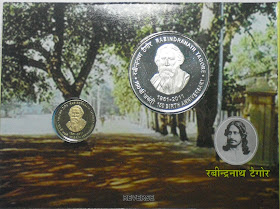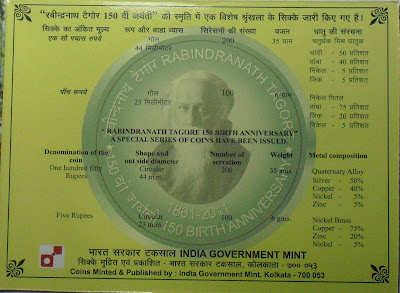Rabindranath Tagore proof set cover

Rabindranath Tagore at different stages in his life

Tagore proof set reverse
 The picture which provides the background is the Shantiniketan, which was initially a university founded by Rabindranath Tagore and is now known as a popular getaway and a peaceful sojourn. The name of shantiniketan means the abode of peace. The univeristy boasts of some illustrious students like Indira Gandhi, Satyajit Ray, Abdul Ghani Khan, Jahar Dasgupta and Amartya Sen.
The picture which provides the background is the Shantiniketan, which was initially a university founded by Rabindranath Tagore and is now known as a popular getaway and a peaceful sojourn. The name of shantiniketan means the abode of peace. The univeristy boasts of some illustrious students like Indira Gandhi, Satyajit Ray, Abdul Ghani Khan, Jahar Dasgupta and Amartya Sen.
Rabindranath Tagore 150rupee obverse

Rabindranath Tagore 5 rupee
 Rabindranath Tagore was born to Debendranath Tagore, a leader of the Brahmo Samaj and head of a wealthy Brahmin family in Calcutta in 1861. He had a brief tenure in London in 1878 where he studied law, but then he returned to his home town Calcutta. for many years he had some success in his locality as a writer. His poems were published in a friend's magazine and at times he himself played the characters portrayed in his plays. His work was entirely in Bengali, and needless to say, he was little known outside of his home town, much less outside of India. In 1912, Tagore decided to complete his law studies. His age was 51 at this time and his son accompanied him on his voyage. On the way to London, he started translating his poems into English just to pass his time, and thus compiled some handwritten translations in a notebook. His son left his father's briefcase containing this notebook in London, and as it so happened, it was chanced upon by some honest man, who returned their belongings. On learning about the existence of these translated poems,Rothenstein, who was a famous artist and also Tagore's friend, requested him to let him read the peoms. When a reluctant Tagore finally relented, Rothenstein was astonished by the beauty of the poems, and later talked W.B. Yeats into reading Tagore's work.Perhaps this was the first time some Westerner had got to read poems and stories by some Indian.
Rabindranath Tagore was born to Debendranath Tagore, a leader of the Brahmo Samaj and head of a wealthy Brahmin family in Calcutta in 1861. He had a brief tenure in London in 1878 where he studied law, but then he returned to his home town Calcutta. for many years he had some success in his locality as a writer. His poems were published in a friend's magazine and at times he himself played the characters portrayed in his plays. His work was entirely in Bengali, and needless to say, he was little known outside of his home town, much less outside of India. In 1912, Tagore decided to complete his law studies. His age was 51 at this time and his son accompanied him on his voyage. On the way to London, he started translating his poems into English just to pass his time, and thus compiled some handwritten translations in a notebook. His son left his father's briefcase containing this notebook in London, and as it so happened, it was chanced upon by some honest man, who returned their belongings. On learning about the existence of these translated poems,Rothenstein, who was a famous artist and also Tagore's friend, requested him to let him read the peoms. When a reluctant Tagore finally relented, Rothenstein was astonished by the beauty of the poems, and later talked W.B. Yeats into reading Tagore's work.Perhaps this was the first time some Westerner had got to read poems and stories by some Indian.
Yeats was enthralled in the least by the beauty and spirtituality of the poems. He later on wrote the introduction to Gitanjali when it was published in September 1912. In due course of time, both Tagore and his poems became a sensation in London and later on in the whole world. It was no less than a window to the mysticism and the spiritual beauty the East had to offer. Never before had anyone read anything like it. In 1913, Tagore became the first non-Western person to win a Nobel prize for his literary works. He thus became famous overnight and began touring the world and taking lectures on promoting inter-cultural harmony. The then British monarch honoured him with the knighthood in 1915, though he relinquished his title in 1919 in protest to the Jallianwala Bagh massacre in Amritsar in which about 400 peaceful demonstrators were mercilessly killed. Even when not travelling, he remained active as a literary, spiritual and socio-political force.
Although a good friend of Mohandas Karamchand Gandhi, most of the time Tagore stayed out of politics. He was opposed to nationalism and miltiarism as a matter of principle, and instead promoted spiritual values and the creation of a new world culture founded in multi-culturalism, diversity and tolerance. He served as a spiritual and creative beacon to his countrymen, and indeed, the whole world. He used the funds from his writing and lecturing to expand upon the school he had founded in 1901 now known as Visva Bharati . The alternative to the poor system of education imposed by the British, combined the best of traditional Hindu education with Western ideals. Tagore's multi-cultural educational efforts were an inspiration to many, including his friend, Count Hermann Keyserling of Estonia. Count Keyserling founded his own school in 1920 patterned upon Tagore's school, and the ancient universities which existed in Northern India under Buddhist rule over 2,000 years ago under the name School of Wisdom. Rabindranath Tagore led the opening program of the School of Wisdom in 1920, and participated in several of its programs thereafter. He wrote over one thousand poems; eight volumes of short stories; almost two dozen plays and play-lets; eight novels; and many books and essays on philosophy, religion, education and social topics. Aside from words and drama, his other great love was music, Bengali style. He composed more than two thousand songs, both the music and lyrics. Two of them became the national anthems of India(Jana Gana Mana) and Bangladesh(Amar Shonar Bangla).He is the only person whose works have been adopted by two different countries as their national anthems. Also, Sri Lanka's national anthem Matha was written by Anand Samarakoon in 1940, who happened to be Tagore's student and his works were also inspired by the man. In 1929 he even began painting. Many of his paintings can be found in museums today, especially in India, where he is considered the greatest literary figure of India of all times.
Tagore was not only a creative genius, he was a great man and friend to many. For instance, he was also a good friend from childhood to the great Indian Physicist, Bose. He was educated and quite knowledgeable of Western culture, especially Western poetry and Science. This made him a remarkable person, one of the first of our planet to combine East and West, and ancient and modern knowledge. Tagore had a good grasp of modern - post-Newtonian - physics, and was well able to hold his own in a debate with Einstein in 1930 on the newly emerging principles of quantum mechanics and chaos. His meetings and tape recorded conversations with his contemporaries such Albert Einstein and H.G. Wells, stand as cultural landmarks, and show the brilliance of this great man. Although Tagore is a superb representative of his country - India - the man who wrote its national anthem - his life and works go far beyond his country. He is truly a man of the whole Earth, a product of the best of both traditional Indian, and modern Western cultures. The School of Wisdom is proud to have him as part of its heritage. He exemplifies the ideals important to us of Goodness, Meaningful Work, and World Culture. Tagore breathed his last in 1941.
Tagore manuscript
 The above is a famous manuscript of Rabindranath Tagore. This is verse no. 44 from the phase “Swadesh” of the songs written by Gurudev Sri Rabindranath Tagore.
The above is a famous manuscript of Rabindranath Tagore. This is verse no. 44 from the phase “Swadesh” of the songs written by Gurudev Sri Rabindranath Tagore.A transliteration of the above verses is as follows:
Bidhir badhon katbe tumi
Emon shaktiman
Tumi ki emoni shaktiman !
Aamader bhanga gara tomar hate
Emon abhiman
Tomader emoni abhiman
Chirodin tanbe pichhe
Chirodin rakhbe niche
Eto bal nai re tomar
Shabe na shei tan
Shashone jatoi ghero
Aachhe bal durbalero
Hao na jatoi baro
Aachhen Bhagoban
Aamader shakti mere
Torao baachbi ne re
Bojha tor bhari holei
Dub be tori khan !
Tagore proof set composition




No comments:
Post a Comment